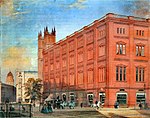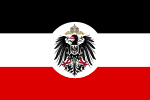Brandenburg-Prussia (German: Brandenburg-Preußen; Low German: Brannenborg-Preußen) is the historiographic denomination for the Early Modern realm of the Brandenburgian Hohenzollerns between 1618 and 1701. Based in the Electorate of Brandenburg, the main branch of the Hohenzollern intermarried with the branch ruling the Duchy of Prussia, and secured succession upon the latter's extinction in the male line in 1618. Another consequence of the intermarriage was the incorporation of the lower Rhenish principalities of Cleves, Mark and Ravensberg after the Treaty of Xanten in 1614.
The Thirty Years' War (1618–1648) was especially devastating. The Elector changed sides three times, and as a result Protestant and Catholic armies swept the land back and forth, killing, burning, seizing men and taking the food supplies. Upwards of half the population was killed or dislocated. Berlin and the other major cities were in ruins, and recovery took decades. By the Peace of Westphalia, which ended the Thirty Years' War in 1648, Brandenburg gained Minden and Halberstadt, also the succession in Farther Pomerania (incorporated in 1653) and the Duchy of Magdeburg (incorporated in 1680). With the Treaty of Bromberg (1657), concluded during the Second Northern War, the electors were freed of Polish vassalage for the Duchy of Prussia and gained Lauenburg–Bütow and Draheim. The Treaty of Saint-Germain-en-Laye (1679) expanded Brandenburgian Pomerania to the lower Oder.
The second half of the 17th century laid the basis for Prussia to become one of the great players in European politics. The emerging Brandenburg-Prussian military potential, based on the introduction of a standing army in 1653, was symbolized by the widely noted victories in Warsaw (1656) and Fehrbellin (1675) and by the Great Sleigh Drive (1678). Brandenburg-Prussia also established a navy and German colonies in the Brandenburger Gold Coast and Arguin. Frederick William, known as "The Great Elector", opened Brandenburg-Prussia to large-scale immigration ("Peuplierung") of mostly Protestant refugees from all across Europe ("Exulanten"), most notably Huguenot immigration following the Edict of Potsdam. Frederick William also started to centralize Brandenburg-Prussia's administration and reduce the influence of the estates.
In 1701, Frederick III, Elector of Brandenburg, succeeded in elevating his status to King in Prussia. This was made possible by the Duchy of Prussia's sovereign status outside the Holy Roman Empire of the German Nation, and approval by the Habsburg emperor and other European royals in the course of forming alliances for the War of the Spanish succession and the Great Northern War. From 1701 onward, the Hohenzollern domains were referred to as the Kingdom of Prussia, or simply Prussia. Legally, the personal union between Brandenburg and Prussia continued until the dissolution of the Holy Roman Empire in 1806. However, by this time the emperor's overlordship over the empire had become a legal fiction. Hence, after 1701, Brandenburg was de facto treated as part of the Prussian kingdom. Frederick and his successors continued to centralize and expand the state, transforming the personal union of politically diverse principalities typical for the Brandenburg-Prussian era into a system of provinces subordinate to Berlin.












